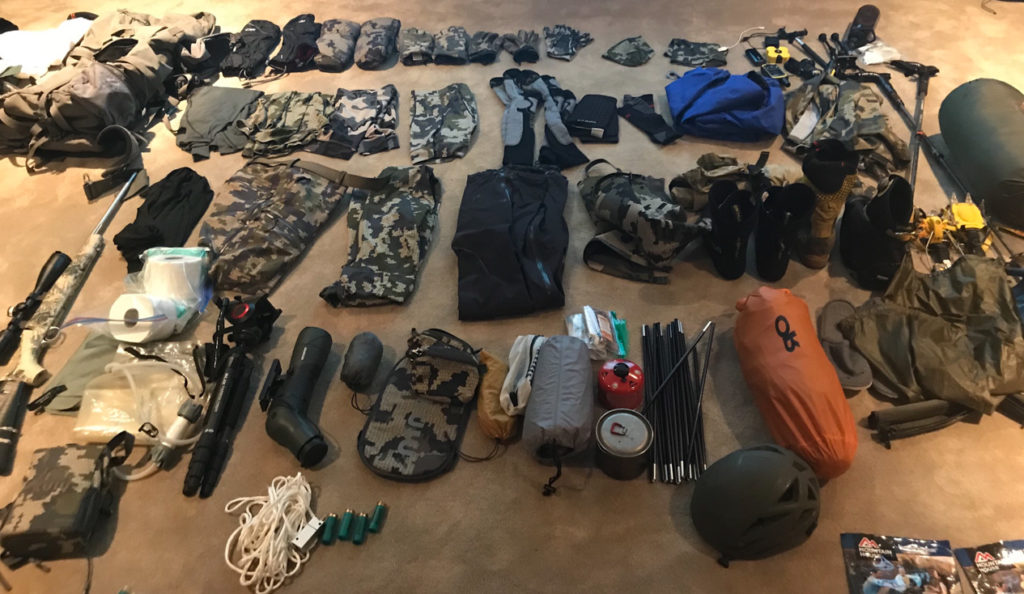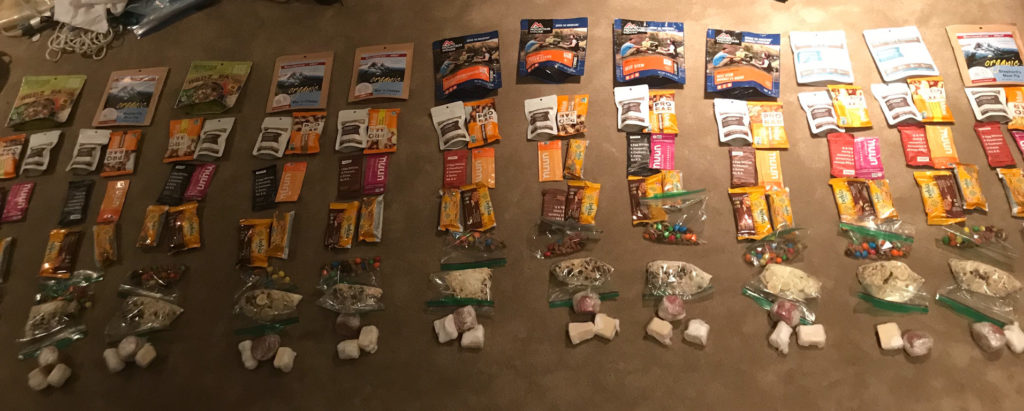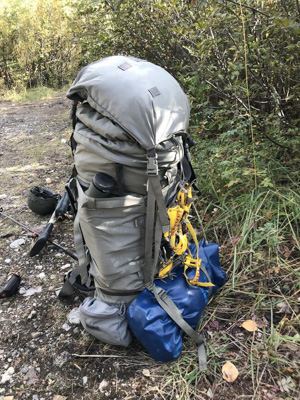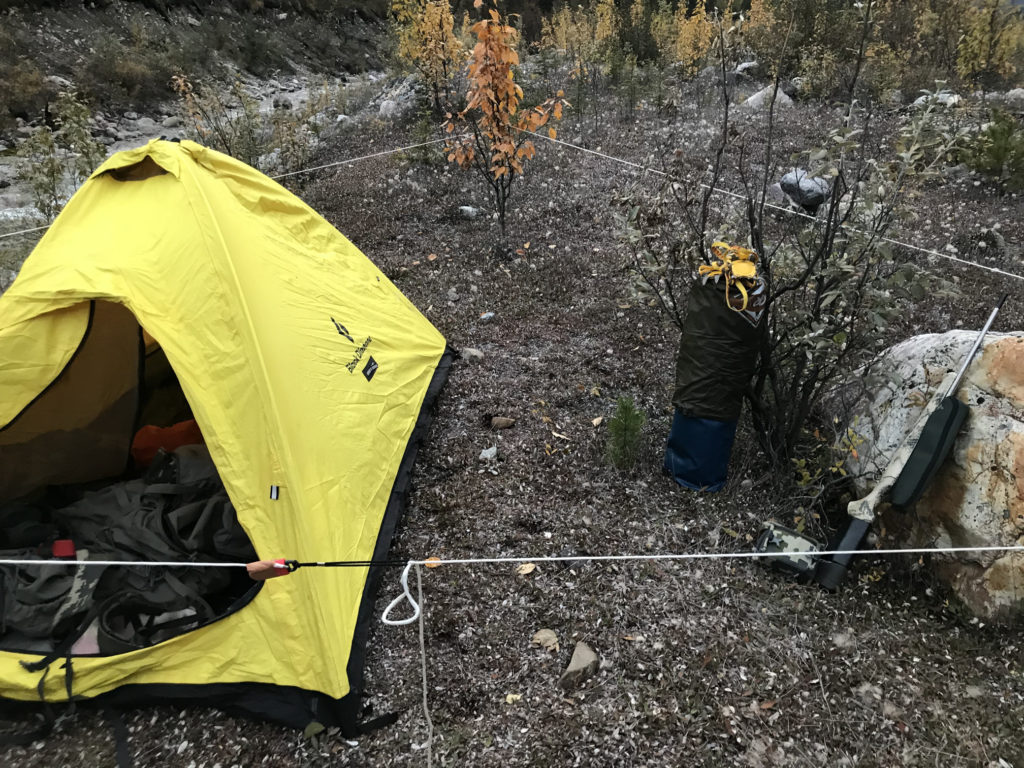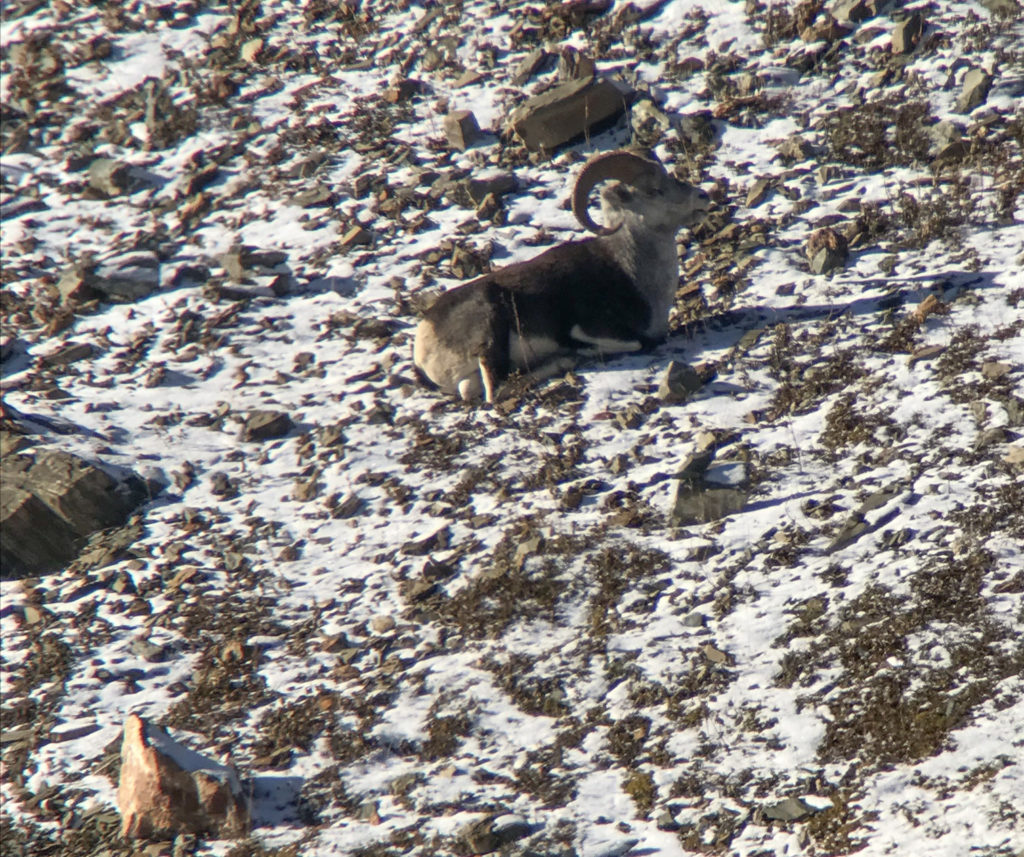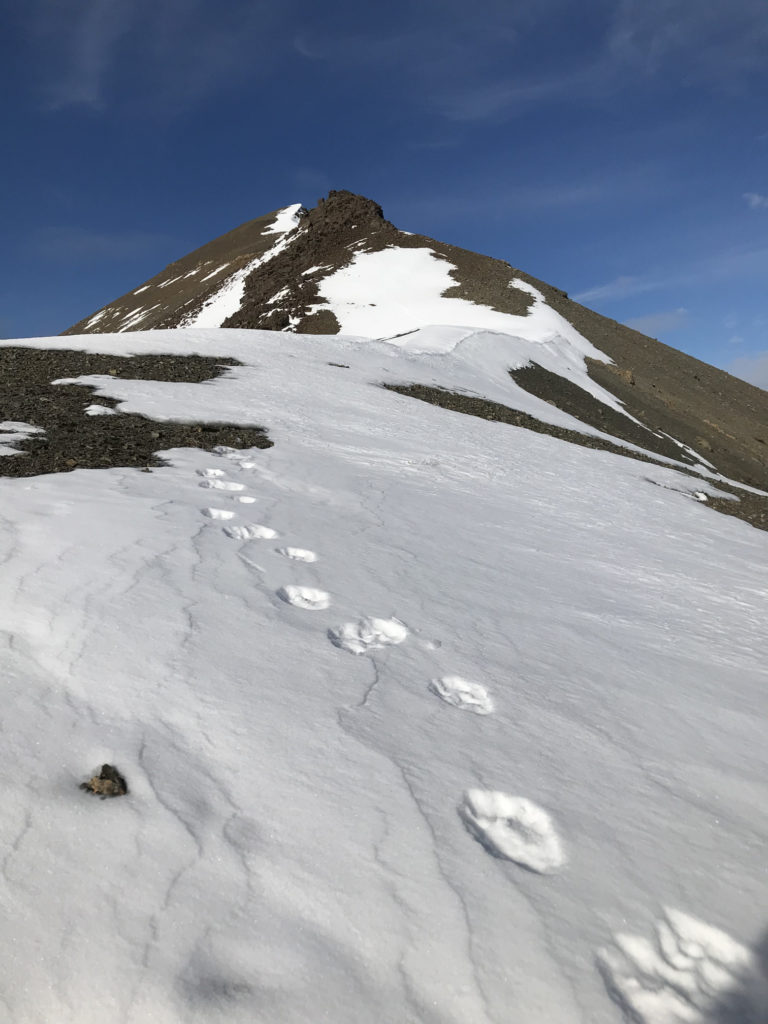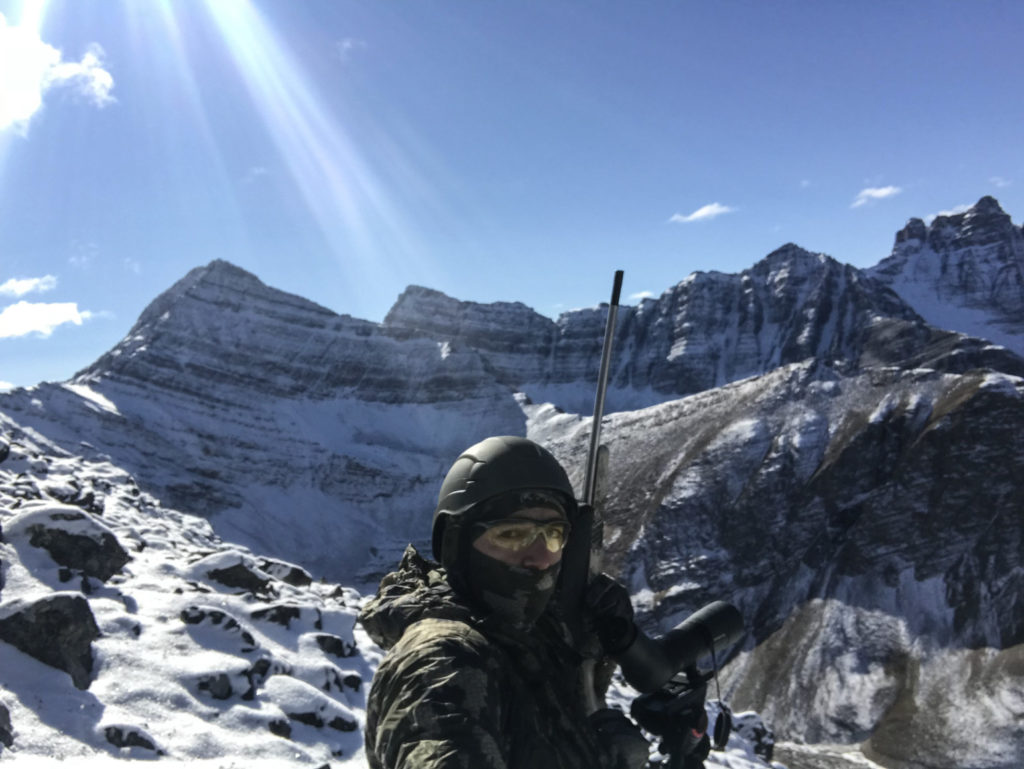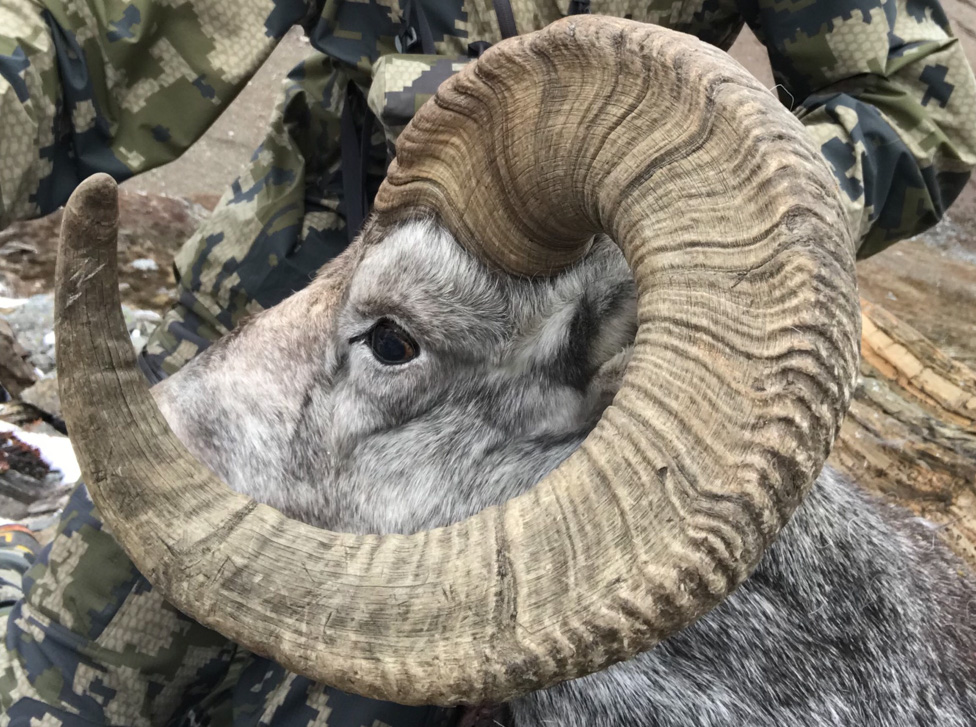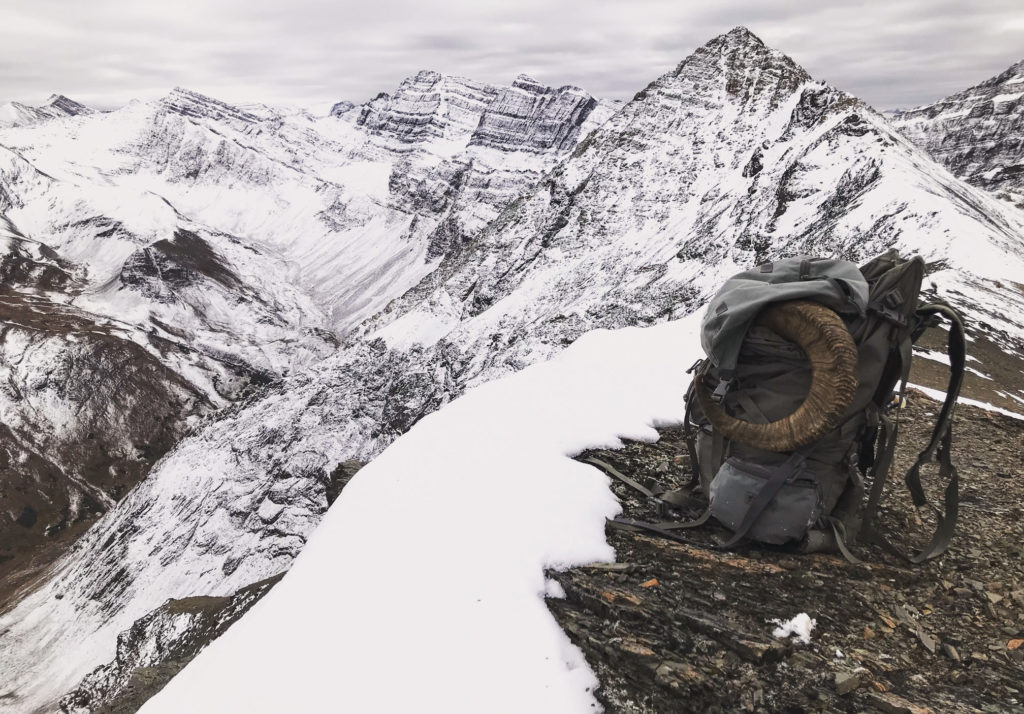I have been a mountaineer and fisherman for most of my adult life, but never a hunter.
Four years ago I became intrigued by mountain hunting. While I had never fired a single bullet, I quickly became fascinated, particularly with mountain goat and sheep. I bought my first firearm, a Kimber Mountain Ascent chambered in 308 Winchester and topped it with a quality scope. I went to the range and pulled the trigger on a firearm for the first time in my life… and I was awful. I continued to practice for a year and got better, but not sniper better. Then I got advice on bedding my rifle. I sent it off to a gunsmith and I paid an experienced shooter to reload for my rifle. I practiced continually with new handloads and my bedded rifle. Now I felt like a sniper.
Three years ago I went on my first ever hunt, for mountain goat. Figuring there are more opportunities for a mountain goat than sheep, I set my sights on the East Kootenays. I chose my location with very little intel, simply looking up mountain goat surveys in the East Kootenays, I purchased my tag and went. Being a seasoned mountaineer and a new hunter, I leaned on my skillset and just climbed high into the area I was hunting. During that trip, I saw several nannies and kids, however, no billies.
Though I wasn’t successful, not even in finding a billy, it was super exciting. The next year I decided to go again solo, though this time it would be in November when the billies were rutting. Now that trip will be for another story because it was an epic goat hunt, but in the end, I got my billy.
In 2017 I decided to hunt Stone Sheep with a hunting partner. Much like my first mountain goat hunt, I had little intel except for some “word of mouth”, and the HuntingBC forums — I spent weeks trying to sift through it all. Ultimately, I chose to hunt a drainage off the Alaska highway. Google Earth imagery on the area looked good, and I thought I was all ninja-like finding this spot. My partner and I arrive at our trailhead, only to find the guide-outfitter trucks already parked there. We pushed on ahead, regardless of the company, and saw plenty of game but no sheep. Despite the lack of sheep, we learned a lot on that trip. Through the observation of sheep trails and droppings and what I’ve read, we got an idea of what they do in that particular drainage.
The day I got home from that trip, I was already starting to plan my 2018 sheep hunt. However, later that year I had a terrible ankle injury during a down climb, during a buddies goat hunt that didn’t pan out — leaving us both injured. I was in constant rehab for my ankle while continually training the rest of my body in the hopes that my ankle would heal up by the next year. I bought a Jack O’Connor book on sheep hunting in the off-season, becoming even more obsessed with sheep.
During my recovery, I continued to train with my rifle and body. My ankle got better by July, though my hunting partner was still hurt so I decided to go solo. While I enjoy hunting with a partner, there is part of me that revels in the challenge of harvesting mountain game solo.. so I keep coming back to it. As the season approaches, I got all my gear ready and started to make a plan.
This year, I decided to chase Stones in mid-September. I figured by this time of year, the guides will have moved on to different species, and the resident pressure would be less. I knew it would take me two days to hike in with a pack that weighed nearly 70lbs. This may not seem like a lot of weight to a seasoned mountain hunter, but as a longtime mountaineer and ultralight gear nut, it felt like a ton. The problem is, mid-September in the northern Rockies can have a wider range of temperature changes than one would encounter on an early August sheep hunt. I had to plan for ice/snow conditions as well as soaking wet conditions. As well as enough food — calories are key — for 12 days. Needless to say, pack weight jumped up on me.
After months of training and planning, and two days on the trail I finally got to my base camp. It’s a surreal feeling being surrounded by the northern Rockies and completely alone. It’s such a mental game as well, but keeping busy is best. Setting tasks and getting them done keeps your mind focused. So at my base camp, I set up all my Grizz protection. I have a trip-line set around my camp with a 120-decibel alarm. I also have a second trip-line on my food stash that features a 12 gauge flash-bang blank I screw into a branch.
Grizz protection while hiking is my rifle with quick access off of my Kifaru gun bearer. As a possible last-ditch bit of insurance, I connect a handheld marine flare to the front shoulder strap on my pack that I can just grab pull a string on to release a 16’000 candlepower red-light with smoke. I also wear a solid mountaineering helmet, with no vents.
The food bag I chose one of the thicker waterproof bags. It’s heavier than the sil-nylon options, but it protects better from rodents too. The weather at this point was dry and not too windy, which I was thankful for, but it was so cold. Cold enough that I was constantly battling frozen water in my bottle — remedied by wrapping it in my down jacket for insulation. My boots were frozen too, from creek crossings while still in the valley. The runoff creeks at higher elevations were frozen waterfalls.
On my third day in the mountains, I climbed into a basin, began glassing, and I saw sheep for the first time in my life. I climbed high. In part, because that’s what I like doing, but also to get a better vantage point to glass a larger section of the basin. The air was frigid on the mountain, and I had to move my water inside my jacket to keep the rest of it from freezing. Glassing was a bit of a trip. With the landscapes dotted in snow, it all looked like white sheep butts. I don’t have enough experience, however, I would think that dotted with snow is harder to glass than no snow or all snow. But when I came across a slight head movement in my glassing, my heart skipped a beat. A ram!!
And around him, there were three more all hanging out on the slope across from me. My heart was beating out of its chest when I saw those rams. I zoom in on them excitedly, only to find out they are all immature. It’s funny how you try and try to will those things to curl just a bit more. Nevertheless, I was excited that I actually got to see rams for the first time. I made my way back to camp that night, and go to sleep excited at what the next day will bring.
The following morning, I decide to climb into a different section of the drainage that is also accessible. Once again I climb high to a vantage point and begin glassing, and once again… more rams!!
There in front of me, a band of rams were grazing at the foot of an escape route, but just like the previous day, they were all immature. I stared through my spotter for longer, again trying to make those horns curl more or have grandpa come around but neither happened. I saw nothing else that day, and I just got this gut feeling that the full curl rams were not here in this drainage, or had been taken by the guides or other residents earlier in the year. So I made a new plan based on my knowledge of the escape routes, and mountain climbing. These routes go up some nasty stuff into a completely different drainage. I could just tell based on the task of climbing out of the escape routes that very few if any, people have done it. The next day I plan to climb it.
That night in camp was bone-chilling. Even with a -20C rated sleeping bag I am still cold. Inside my bag, I wore my down jacket, down pants, and wrapped a second down jacket around my feet. By morning everything in the tent was frozen except what was in the sleeping bag.
Meticulously, I picked apart the route to climb out of the drainage I was in and I figured out a line. I strapped on my crampons and started my ascent. The climb out was sketchy and gruelling, six hours of nasty technically challenging terrain. Frozen sections of rock and ice were mixed in with large loose boulders. I have been climbing for most of my life, and I’ve summited some of the higher mountains of British Columbia and Washington State. Suffice it to say, I’m comfortable in this element, but the implications of being alone can’t be diminished. One wrong step and I’m f***ed. I reached the summit ridge and looked down into a new drainage, knowing that very few, if any, people had ever looked into it. Adding to the awe of this moment was a fresh set of wolverine tracks following the ridgeline.
It seemed wild to me at the time that a wolverine would be hanging out up here, as it’s desolate at that altitude. But I suppose he is hunting from above just like me. Looking over the basin, the winds picked up and the clouds began to roll in. I take my spotting scope and glass into the valley below while looking over my back to make sure that the wolverine isn’t lurking above me.
After a half hour behind the glass, I see a lone ram. Instantly a lump builds in my throat. I put the 60x on him and he is a beast. The ram is obviously full curl and grazing at the bottom of the drainage. I talk to myself to settle down while checking my watch, time is against me but #*$@ it I can’t pass this up. I begin down climbing feverishly into this new basin, trying to be quiet but its difficult in the rocks. The old ram is on high alert, he knows something is up. Every time I stop and glass again I can see his head is up, trying to find out what the sound is. He doesn’t think to look up. Each time this happens, I wait until he starts grazing again before I down climb some more. My heart is racing. The variables I’m dealing with at this point are nearly overwhelming. My greatest concern is “do not fall”, followed by “do not spook him” and “if I can kill him, can I get out before dark” because the temperature is dropping and I am a long ways away from camp.
There are three cruxes to navigate on the way down — in mountaineering terms, a crux is defined as the most difficult section of a route, or where the greatest danger exists. Each of the three cruxes is a five to ten-metre section where I need to rock climb down, facing the rock. I get past them and see in the distance an obvious cliff that is not climbable. The ram starts grazing towards the base of the cliff that I am approaching from above. He is now out of sight. I see on the far left there is a way to circumnavigate the cliff but I decide to try to get the shot from the cliff ledge directly above him. I inch my way down to the cliff on my ass, stopping from time to time to stand to see if he is still there, he is but he continues to graze towards the base of the cliff. The shale rock is so unforgiving in the steep slope and I do all I can to not let a rock roll over the cliff.
Finally, I get to the cliff ledge and position myself right at the cliff lip, wedging myself into the rocks so I don’t fall as I look directly down. My Swarovski EL Range gives me an adjusted distance of 206 yards to the ram. I put the crosshairs on his vitals, but my rest and body are all awkward. I start to panic, so much is riding on this shot as I realize just how effing big he is. Holy &$@&. I can’t manage my heart rate, my confidence in being a “sniper” is out the window, the variables are all running through my head. I go blank, forgetting to go through my shooting routine. The reticle is shaking a bit but I still pull the trigger. I never do that. He jumps but starts running away. I panic more. I reset to try and shoot again. He slows, I pull the trigger but I miss and he runs away further. He runs some more and slows, I shoot one more time but miss again. At this point, the distance is so much greater and taken a range or adjusted my turret. In one final show, he looks back at me, turns, and walks over a ledge. Just like that, he was gone.
I have cried three times in my adult life. When both my daughters were born, and when my dog died. But when the ram of my dreams went over the ledge I pretty much cried like a child. I knew I may never in my life find another ram like that. I knew I couldn’t chase after him because I was too far from camp, and I could freeze to death if I tried an overnight bivy in these temperatures. Even though I was so confident I hit him on the first shot I started second guessing myself. Maybe I didn’t even hit him. The angle was nearly 80 degrees so the jump I perceived could have just been him spooking and running, he had slowed but not swayed and I didn’t do my routine before my shot. Then I went back to “but I’m sure I got him.” Regardless I had to get back to camp. To circumnavigate the cliff and to chase him I could go hypothermic if I got too far. It was also far too dangerous to scale class 4 and 5 rock in the dark. So I started back for camp. And climbing out after what just happened was one of the top ten worst feelings in my life. I kept thinking to myself “why do I do this?”. If I had got him it would have been the top ten best things in my life. Where is the middle ground in this type of trophy hunting?.
I got back to camp late. Mentally and physically exhausted, I still couldn’t sleep, tossing and turning all night. What just happened? Is he dead? Is he wounded? Did I miss? Is he gone? Is he still there… I realize too just how far he is from my sleeping bag at that moment. I’ll have to climb out of the drainage I’m in, and rock climb down those sketchy sections again. Then circumnavigate the cliff where I made the shot to go look over the ledge where I last saw him and see where to go from there. But whatever the outcome, I had to do it.
I woke up a couple hours before light and everything is frozen again. I hate getting ready in the dark when everything is frozen. It sucks. I hate taking a crap when it’s dark and frozen while holding a rifle and looking for bears. With my gear finally on I mentally prepare myself for the day. I can’t underestimate the logistics of getting to this location. Sketchy scrambling up and down in crampons. The mental anguish from the uncertainty was so heavy. I just focused on staying safe because there are a lot worst things in life — even though it was hard to believe at that moment — then not getting my dream ram. I make my pack feather light, only packing emergency gear. It’s finally light enough to see without a headlamp as I reach the technical spots. I make the long, long climb out of the drainage. Once I get to summit ridge I see wolverine tracks again, this time over my tracks from the last night. The wolverine has obviously been following or stalking me, but I’m just glad it isn’t a grizzly. I down climb slowly, getting all the way back to the cliff ledge where I had made the shot. I make the scramble to circumnavigate it. Slowing my pace, I start scanning the rock and snow close to where he was standing when I shot. My body shivers… Holy shit! I see blood! I knew I was a sniper! I am nearly overwhelmed, as I almost start running to the location where he went over the ledge. More blood. I peer over that ledge and see not a cliff drop but a second ledge and the ram of my dreams laying dead.
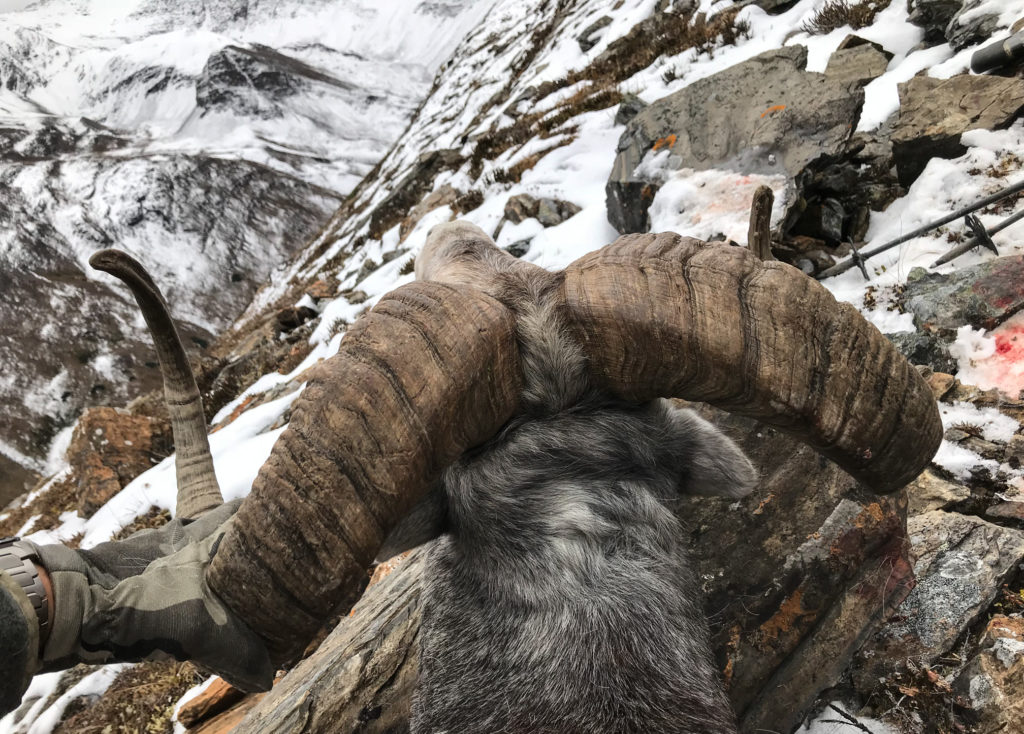
Faint relief, absolute jubilation, and a little panic flood my senses. I just couldn’t really take in what I was seeing. I was in shock. But not enough shock that I couldn’t take my hero pics.
I was emotional. While I may not have been pursuing sheep for that long when compared to others, I put in so much hard work in my prep. All the podcasts, books, forum reading, gear testing, family support issues, shooting practice, time in the gym and on the effing stairmaster wearing mountaineering boots and 60lb pack — while Lululemon crowd looked at me funny. It was all worth it. This was my dream ram, even if that damn wolverine following me got some of the sheep. The front leg had been chewed clean off.
After my photos, I began skinning feverishly because I know time was still against me. I felt the hairs on my neck stand as if I was being watched. Whatever ate that leg — wolverine or other — I feel as though it was watching me. I skinned the hide but left the head on, for now, loading the cape and deboned meat into my pack. I notice all my water is frozen solid, but thankfully my emergency gear includes a stove and fuel for water. I melt some snow, pouring it into the bottle with electrolytes, and get ready for a climb out that I wasn’t sure was possible. The three big cruxes of five to ten metres sections on the way to the top of the ridge weren’t possible with the weight on my back. The pack was just too heavy to manage these sections, so I had to take out the head move it up, take out the meat move it up as high I could reach. Climb a couple metres and repeat to get these technical sections, slow and steady. When I finally got to the wolverine tracks at the top of the ridge I was elated. It was all downhill from there.
I managed to get back to camp just as the sun was setting, knowing that sleep would come to me easily that night. The following day was spent processing and cleaning everything in preparation for my hike back to civilization. I also took plenty of time to rest, and admire everything that had transpired. That day of rest was much needed.
On my final morning in the mountains, I crammed my entire camp, cape, head, and meat into my pack and set out. At 6’1” and 170lbs, with a pack over a 120lbs, I was wobbly on my feet. I dumped my remaining food to help weight management and hiked out. I’m very methodical and all business on these trips. Even when I was in the bush and had harvested the ram of my dreams I kept saying to myself “settle down don’t get too excited you still have to hike out and stay safe…. careful of bears … stay on track etc”. But when I got to the truck .. that’s when I truly let it all out. I was screaming for joy on my accomplishment. The compulsory Inspector told me my ram was twelve years old, and 38” long — one of the biggest he had recorded from the area. A solo hunt is challenging and exhilarating, an adventure I cherish deeply. But in my opinion, without sharing it, it’s kinda just caged up in your own mind. I am thankful to be able to hunt sheep successfully, but also to be able to share my story. I hope this inspires you all to chase the ram of your dreams — wherever that may take you.


